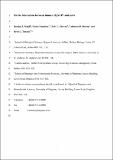Files in this item
On the interaction between human IQGAP1 and actin
Item metadata
| dc.contributor.author | Magill, Damian | |
| dc.contributor.author | Hamilton, Elaine | |
| dc.contributor.author | Shirran, Sally Lorna | |
| dc.contributor.author | Botting, Catherine Helen | |
| dc.contributor.author | Timson, David | |
| dc.date.accessioned | 2017-02-05T00:32:39Z | |
| dc.date.available | 2017-02-05T00:32:39Z | |
| dc.date.issued | 2016 | |
| dc.identifier | 240593640 | |
| dc.identifier | 83095d5c-bb62-488d-99dc-fb16d6a0048d | |
| dc.identifier | 84961744772 | |
| dc.identifier | 000373715300009 | |
| dc.identifier.citation | Magill , D , Hamilton , E , Shirran , S L , Botting , C H & Timson , D 2016 , ' On the interaction between human IQGAP1 and actin ' , Protein & Peptide Letters , vol. 23 , no. 4 . https://doi.org/10.2174/0929866523666160204123331 | en |
| dc.identifier.issn | 0929-8665 | |
| dc.identifier.other | ORCID: /0000-0003-3516-3507/work/32169106 | |
| dc.identifier.uri | https://hdl.handle.net/10023/10230 | |
| dc.description | DM thanks the School of Biological Sciences, Queen’s University, Belfast for a summer studentship and EH thanks the Department of Employment and Learning, Northern Ireland for a postgraduate studentship. The work was funded in part by grants from the BBSRC (BB/D000394/1 To DJT) and by the Wellcome Trust [grant number GR06281AIA] which funded the purchase of the QStar XL mass spectrometer at the BBSRC Mass Spectrometry and Proteomics Facility, University of St Andrews and funded SLS. | en |
| dc.description.abstract | IQGAPs are eukaryotic proteins which integrate signals from various sources and pass these on the cytoskeleton. Understanding how they do this requires information on the interfaces between the proteins. Here, it is shown that the calponin homology domain of human IQGAP1 (CHD1) can be crosslinked with α-actin. The stoichiometry of the interaction was 1:1. A molecular model was built of the complex and associated bioinformatics analyses predicted that the interaction is likely to involve an electrostatic interaction between Lys-240 of α-actin and Glu-30 of CHD1. These residues are predicted to be accessible and are not involved in many intra-protein interactions; they are thus available for interaction with binding partners. They are both located in regions of the proteins which are predicted to be flexible and disordered; interactions between signalling molecules often involve flexible, disordered regions. The predicted binding region in CHD1 is well conserved in many eukaryotic IQGAP-like proteins. In some cases (e.g Dictyostelium discoideum and Saccharomyces cerevisiae) protein sequence conservation is weak, but molecular modelling reveals that a region of charged, polar residues in a flexible N-terminus is structurally well conserved. Therefore we conclude that the calponin homology domains of IQGAP1-like proteins interact initially through the electrostatic interaction identified here and that there may be subsequent conformational changes to form the final complex. | |
| dc.format.extent | 237635 | |
| dc.language.iso | eng | |
| dc.relation.ispartof | Protein & Peptide Letters | en |
| dc.subject | α-actin | en |
| dc.subject | Calponin homology domain | en |
| dc.subject | CHD | en |
| dc.subject | IQGAP-like protein | en |
| dc.subject | Protein flexibility | en |
| dc.subject | Protein-protein crosslinking | en |
| dc.subject | QR Microbiology | en |
| dc.subject | QD Chemistry | en |
| dc.subject | NDAS | en |
| dc.subject.lcc | QR | en |
| dc.subject.lcc | QD | en |
| dc.title | On the interaction between human IQGAP1 and actin | en |
| dc.type | Journal article | en |
| dc.contributor.sponsor | The Wellcome Trust | en |
| dc.contributor.institution | University of St Andrews. School of Biology | en |
| dc.contributor.institution | University of St Andrews. School of Chemistry | en |
| dc.contributor.institution | University of St Andrews. EaSTCHEM | en |
| dc.contributor.institution | University of St Andrews. Biomedical Sciences Research Complex | en |
| dc.identifier.doi | 10.2174/0929866523666160204123331 | |
| dc.description.status | Peer reviewed | en |
| dc.date.embargoedUntil | 2017-02-04 | |
| dc.identifier.grantnumber | 094476/Z/10/Z | en |
This item appears in the following Collection(s)
Items in the St Andrews Research Repository are protected by copyright, with all rights reserved, unless otherwise indicated.

